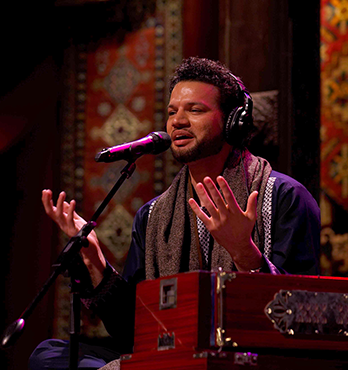Mram Mram

by Ayesha binte Rashid
Culture loves to travel, and adapts along the way, finding its voice in new languages, befriending new people, not caring for class, caste or religion. It carries with it a wealth of human creativity and tradition. It was on these travels, that culture came upon Shamali Afghan, bringing to him Mram Mram, a song descended from 1960’s Iran.
Mram Mram is a song that brings the universal theme of unrequited love to the mix, but with its own distinctive flavor — it is a song of a broken heart. “ Mram mram mram mram mram,” calls out the despairing singer of our song, “I am dying, I am dying.” The grief of unrequited love is fatal, they say, as is the cruelty they are suffering at the hands of the elusive beloved. “Mram mram mram mram mram.” They are inconsolable, our singer, and the object of their affection has caused them deep grief, misleading them with false promises, burning them worse than any fire could. Whether a broken heart sings in Pashto, Dari, or Farsi, its anguish remains too much to bear.
Mram Mram was born of a Farsi song Zim Zim Zim, originally composed in Iran by Ustad Nainawaz, a poet and musical composer who worked in pre-revolution Iran. The song was picked up by musicians who were at the forefront of Iran’s music scene at the time. A YouTube video shows Iranian singer Farida Mahwish, in her youth, at a recording for Iran’s National TV. With a sitar and harmonium accompanying her voice, she sings, “Zim zim zim.” The words are nothing like the Pashto verses of Shamali’s song but the melody is, unmistakably, the same.
In another video, we see Leila Forouhar dancing onstage to a full house, the audience swaying to her performance. She grabs the mic and, as the verses flow through her voice, the song is unfamiliar. But soon enough, there comes the hook: “Zim zim zim zim zim,” accompanied by that unmistakable melody. Leila’s voice is accompanied by drums and synths — her version of Zim Zim Zim is significantly more fast-paced than Farida Mahwish’s and one feels the sway as we imagine ourselves dancing to this at a party in the 1980’s.
Leila Forouhar is an iconic pop diva whose career started in Iran in the 1960’s; but she soon left the country after the revolution. What we know is that the song left Iran with her and joined in her travels, eventually permeating through the fabric of culture across the globe. The song remains a performance favorite for many Iranian artists as part of their repertoires to this very day. Eventually the song found a home in neighboring Afghanistan.
Search for Soheila Zaland and you’ll find a music video of her on a blue set, curtains draped in the background, a giant chain hanging for effect. Her hair is cut short and she is wearing a black skirt and a shimmery top. In the background, we hear synths, piano and percussions laying a groove to which Soheila dances, and one cannot help but feel the pull to tap their feet alongside her movements. She begins to sing and, yet again, there’s the hook: Zim zim zim zim zim. Soheila is a popular singer in Afghanistan, where Farsi becomes Dari. In its incarnation in Afghanistan, the song continued to evolve in both folk and contemporary colors and has been covered by numerous artists in the country. It was in Afghanistan that Shamali’s father, Shah Wali Afghan, first heard the song.
After the Soviet invasion of Afghanistan, and the subsequent government takeover by the Mujahideen, Shah Wali Afghan moved to Peshawar in Pakistan. A musician by trade, Shah Wali translated the song to Pashto and composed his own rendition in Peshawar during the 1980s. In a studio recording, one can hear a tabla intro. Shah Wali launches into the song and, this time, the melody and words are recognisable: “ Mram mram mram mram mram”. In the background, we hear the harmonium and sarangi while a riff played on the rabab compliments Shah Wali’s vocals.
Eventually, Shah Wali and his family made the move to Canada and with them, the song in its current state, also found its way across continents. It survived in Peshawar, in people’s memories, in their cassette players, played at gatherings, sung in homes. When Shamali started singing, it was passed on to him.
Wearing a blue kurta embellished in white with an Afghani design, Shamali is sitting on a takht at the Coke Studio set. Before he launches into an alaap, Sadiq Sameer plays the rabab, each note echoing clearly, speaking of the long journey that the song has travelled to reach us in this moment. Both song and instrument have history etched into them. As he begins to vocalise notes, Shamali’s voice is reminiscent of his father’s soft vocal quality. The song begins. Mram mram mram mram. Zim zim zim zim zim.
Mram Mram carries with it the story of displacement. Post-revolution Iran saw the demise of pop music in the country due to a cultural ban. Participation of women in performative art such as music became forbidden. Anything other than religiously inclined music or music that spoke of patriotism was removed from the public. Zim Zim found itself shunned by its own home and so it left and found refuge in other countries.
In Afghanistan, where the song had found a temporary home, war had broken out and in the process of it all, the ones who’d come out on top did not approve of music. “They had an allergy to music,” says Sadiq. So, in the dead of night, Zim Zim ran away to neighboring Pakistan with Shah Wali. As it trickled across people and continents, leaving pieces behind in its travels, the song now returns to Pakistan.
This is not a sad story – it’s a story about survival and perseverance. On YouTube, we find a video of four women in traditional Afghani dresses in Washington in 2016. They are dancing, and we hear it again:
Zim zim zim zim zim. Through the decades, crossing continents, the song has survived. Culture loves to travel, it befriends people easily, picks up on new languages, makes new homes in lands that it has never been to before. And, in doing so, it prevails.
